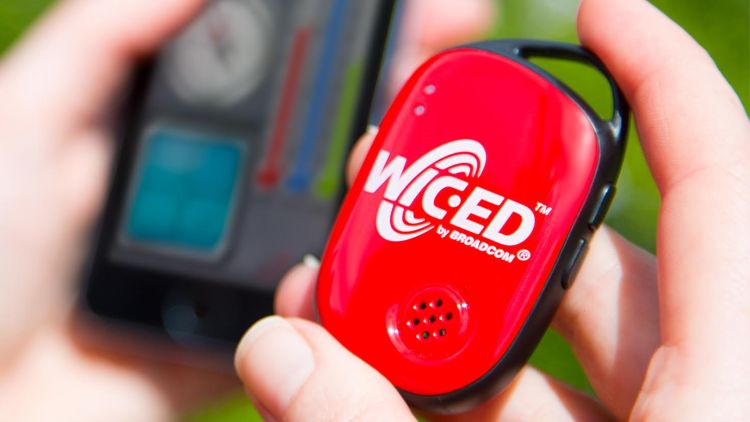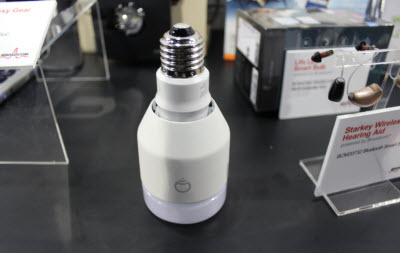Broadcom sells billions of dollars worth of chips in networking, consumer electronics, and communications infrastructure markets. But it’s trying to move beyond that to dominate the market for chips for the “internet of things,” or bringing smart connectivity and sensors to everyday objects.
Scott McGregor, chief executive of Irvine, Calif.-based Broadcom, has more than 12,000 engineers working on chips that will form the backbone of future tech products. And he’s encouraging them to join the movement of hardware hobbyists, known as “makers.” McGregor is encouraging them to experiment with new kinds of hardware devices that tap the power of connectivity and the powerful underlying silicon chips that Broadcom produces.
Broadcom wants to arm all sides in the rush to produce products for the internet of things.
We caught up with McGregor for a recent interview. Here’s an edited transcript.
VentureBeat: What’s new?
Scott McGregor: We recently announced a new switch chip that is pretty fast. It’s 3.2 terabits per second. It’ll do 32 ports of 100 gigabits per second data. It’s going to go into the massive data centers, cloud data centers and stuff like that. It’s a bigger chip than you might normally see, about 3,000 pins, more than 7 billion transistors. More than one for every person on the planet. The speed of this, if you think of a video feed from Amazon or Netflix, this can do one million of those simultaneously.
VB: Who’s in this space? Are you competing head to head against anything?
McGregor: Not many people in the space. Occasionally startups or other companies, but Broadcom is the primary supplier of this technology today.
VB: Is this getting closer into the optical realm?
McGregor: This will do 100 gigabits per second, so that’s all optical. It would have 32 optical connections coming out of that chip. It would go right to optical fibers. It’s in an end of row, top of rack, or core aggregation switch. It’s not in the individual compute things. It’s much too fast for that. It’s the fastest chip that would be in the data center. If you had a huge data center, whether it’s Facebook or Google or Amazon or Alibaba, in their fastest switches, this would be the thing that powers it.
VB: I was just at the 49ers stadium the other day and saw their data center. I think they had 40 gigabits coming into it?
McGregor: They had a challenge, because one of the problems, if you’re going to a stadium and you take a selfie or you want to even send a tweet to someone, getting the data out of the stadium is very hard. You can get it to the cell tower or the wi-fi connection, but then the stadium clogs up and it’s hard to get it out of there.
This is for applications even larger than that. 3.2 terabits per second is two orders of magnitude faster than what you were looking at in the stadium. This would be if you’re Facebook and you have a huge data center somewhere. The thing that whole data center funnels into that then talks to the internet, that’s this kind of chip.
VB: What else is on your mind lately?
McGregor: We have some stuff on wearables that’s fun. We have this thing we do called WICED Sense. It’s 20 bucks, and this is what you get – this little tag and a battery and a USB cable. You get all the source code for an iPhone app and an Android app. You get all the hardware materials and manufacturing Gerbers. For 20 bucks you can be in the business of creating a wearable.
This has a bunch of sensors in it. It’s Bluetooth, FCC certified. It has gyroscopes and barometers and thermometers and a compass and all sorts of accelerometers. I was talking with Quentin. We challenged him to think of something for it, and he said, “Well, you could attach it to a skateboard! Or your kid’s football helmet. You could figure out what the highest impact was.”
There are two things I think are really interesting. One is that this reduces the cost of creating an app and being in the business of creating a product, such that almost anybody can afford, if they have a credit card to charge it, the cost of starting a business. The software is relatively easy to change. There are no license fees. The device is cheap. We give you the source of all the things you can build, and you go into business.
The combination of that and the fact that you now have access to worldwide markets—If you create a niche app, like a skateboard app with this sensor, 10 years ago you weren’t able to reach all the skaters on the planet. If we can build the dev kit for that much, you can build the product for close to that. We think this is going to enable an explosion of devices.
A lot of them will be lame, sure, or excessively niche. It’s like Kickstarter. You look at Kickstarter and there’s a bunch where you say, “Wow, I’d like that!” and a bunch more where you say, “Ehh.” But I think it’s going to be interesting. That’s going to have a follow-on effect of creating an amazing amount of data on the web. Big data is becoming much more interesting. It’s also good for us because it’s going to drive more data through these other chips.
VB: At CES I was asking about the underlying tech behind the internet of things. What’s your assessment of that?
McGregor: People need to be more precise with technologies. I separate the concept of a wearable from the internet of things. I believe a wearable is a smartphone accessory. It’ll typically be tethered to a smartphone for either its application or its access to the internet. It will communicate through Bluetooth. Low energy, low power, coin cell or rechargeable.
Internet of things is more an appliance – a thermostat or a smoke detector or refrigerator or smart meter. It typically communicates through an access point. It uses wi-fi, more likely. It has much more capability. It might be a device itself, visible on the internet, that you can see, like a camera. You can address a camera on the internet.
Those two markets, a lot of people are imprecise and they lump them together. But I believe they’ll develop independently.




